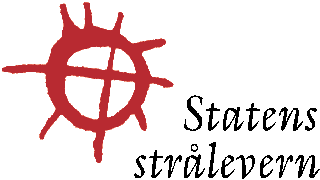|
Norwegian Radiation Protection Authority |
| Photosensitizing effects metalloporphyns in connection with
hyperbilirubinemia
AcknowledgementsThe authors thank Ms. B. Badaro and Ms. G. Gulbrandsen for expert help with tissue culture, and Mr. Tor-Arne Vilnes for help with preparing the text and figures. This study was supported by The Norwegian Cancer Society/Käte Forsbergs fund.
References1. Kappas, A., Drummond, G.S., Manola, T., Petmezaki, S. and Valaes, T., Sn-Protoporphyrin use in the management of hyperbilirubinemia in term newborns with direct Coombs-positive ABO incompatibility, Pediatrics 81 (1988), 485-497 2. Moan, J. and Christensen, T., Porphyrins as tumor localizing agents and their possible use in photochemotherapy of cancer, Tumor Res. 15 (1980), 1-10 3. McDonagh, A.F. and Palma, L.A., Tin-Protoporphyrin: A potent photosensitizer of bilirubin destruction, Photochem. Photobiol. 42 (1985), 261-264 4. Vreman, H.J., Ekstrand, B.C. and Stevenson, D.K.: Selection of metalloporphyrin heme oxygenase inhibitors based on potency and photoreactivity, Pediatric Res. 33 (1993), 195-200 5. Delaney, J.K., Mauzerall, D., Drummond, G.S. and Kappas, A., Photophysical properties of Sn-Porphyrins: Potential clinical implications, Pediatrics 81 (1988), 498-504 6. Christensen, T., Reitan, J.B. and Kinn, G., Single strand breaks in the DNA of human cells exposed to visible light from phototherapy lamps in the presence and absence of bilirubin, J. Photochem. Photobiol. B. Biol., 7 (1990),337-346. 7. Rosenstein, B. S., Ducore, J. M. and Cummings, S. W., The mechanism of bilirubin-photosensitized DNA strand breakage in human cells exposed to phototherapy light, Mutation Res. 112 (1983), 397-406 8. Christensen, T., Cytotoxicity of bilirubin photoproducts, Photobiochem. Photobiophys. 10, (1986), 253-260 9. Christensen, T., Støttum, A., Brunborg, G. and Reitan, J.B., Unwanted side effects and optimization of phototherapy. In R. H. Douglas, J. Moan and F. Dall'Acqua (eds.), Light in biology and medicine. Volume 1, Plenum Press, New York and London, 1988, pp. 153-159 10. Christensen, T., Kinn, G., Granli, T. and Amundsen, I., Cells, bilirubin and light: Formation of bilirubin photoproducts and cellular damage at defined wavelengths. Acta Pædiatr. 83, (1994), 7-12
11. Moan, J., Waksvik, H. and Christensen, T., DNA single-strand breaks and sister chromatid exchanges induced by treatment with hematoporphyrin and light or by x-rays in human cells of the line NHIK 3025, Cancer Res. 40 (1980), 2915-2918 12. Gomer, C.J., Rucker, N., Banerjee, A. and Benedict, W.F., Comparison of mutagenicity and induction of sister chromatid exchange in Chinese hamster cells exposed to hematoporphyrin derivative photoradiation, ionizing radiation, or ultraviolet radiation, Cancer Res. 43 (1983), 2622-2627 13. Stocker, R. and Ames, B.N., Potential role of conjugated bilirubin and copper in the metabolism of lipid peroxides in bile, Proc. Natl. Acad. Sci. USA 84 (1987), 8130-8134 14. Stocker, R., Glazer, A.N. and Ames, B.N., Antioxidant activity of albumin-bound bilirubin, Proc. Natl. Acad Sci. USA 84 (1987), 5918-5922 15. Stocker, R., Yamamoto, Y., McDonagh, A.F., Glazer, A.N. and Ames, B.N., Bilirubin is an antioxidant of possible physiological importance, Science 235 (1987), 1043-1046 16. Undsgard, G., Larsen, B., Dalen, A., Vik, R. and Ringkjøb, R., A new technique to register proliferation of clonogenic cells from brain tumors, J. Neuro-Oncol. 3 (1985), 203-209 17. Yuspa SH, Morgan D. Mouse skin cell resistant to terminal differentation associated with initiation of carcinogenesis, Nature 1981; 293:72-74. 18. Rydberg, B., The rate of strand separation in alkali of DNA of irradiated mammalian cells, Radiation Res. 61 (1975), 274-287 19. McDonagh, A.F., The role of oxygen in bilirubin photo-oxidation, Biochem. Biophys. Res. Comm. 44 (1971), 1306-1311 20. Weishaupt, K.R., Gomer, C.J. and Dougherty, T.J., Identification of singlet oxygen as the cytotoxic agent in photo-inactivation of a murine tumor, Cancer Res. 36 (1976), 2326-2339
21. Di Mascio, P., Menck, C.F.M., Nigro, R.G., Sarasin, A. and Sies, H., Singlet molecular oxygen induced mutagenicity in a mammalian SV 40-based shuttle vector, Photochem. Photobiol. 51 (1990), 293-298 22. Scott, J., Quirke, J.M.E., Vreman, H.J., Stevenson,D.K. and Downum, K.R., Metalloporphyrin phototoxicity, J. Photochem. Photobiol. B. Biol., 7 (1990), 149-157 23. Christensen, T., Moan, J., McGhie, J.B., Waksvik, H. and Stigum, H., Studies of HPD: Chemical composition and in vitro photosensitization. In D. Kessel and T.J. Dougherty (eds.), Porphyrin photosensitization, Plenum Press, New York and London, 1983, pp. 151-164 24. Christensen, T., Sandquist, T., Feren, K., Waksvik, H. and Moan, J., Retention and photodynamic effects of hematoporphyrin derivative in cells after prolonged cultivation in the presence of porphyrin, Br. J. Cancer 48 (1983), 35-43 25. Hintz, S.R., Vreman, H. J. and Stevenson, D.K., Mortality of metalloporphyrin-treated neonatal rats after light exposure, Dev.pharmacol. Ther. 14 (1990), 187-192 26. Keino, H., Nagae, H., Mimura, S., Watanabe, K. and Kashiwamata, S., Dangerous effects of tin-protoporphyrin plus photoirradiation on neonatal rats, Eur. J. Pediatr. 149 (1990), 278-279 27. Nakamura, H., Uetani, Y., Komura, M., Takada, S., Sano, K. and Matsuo, T., Inhibitory action of bilirubin on superoxide production by polymorphonuclear leukocytes, Biol. Neonate 52 (1987), 273-278 28. Kanofsky, J.R., Quenching of singlet oxygen by human plasma, Photochem. Photobiol. 51 (1990), 299-303
|
